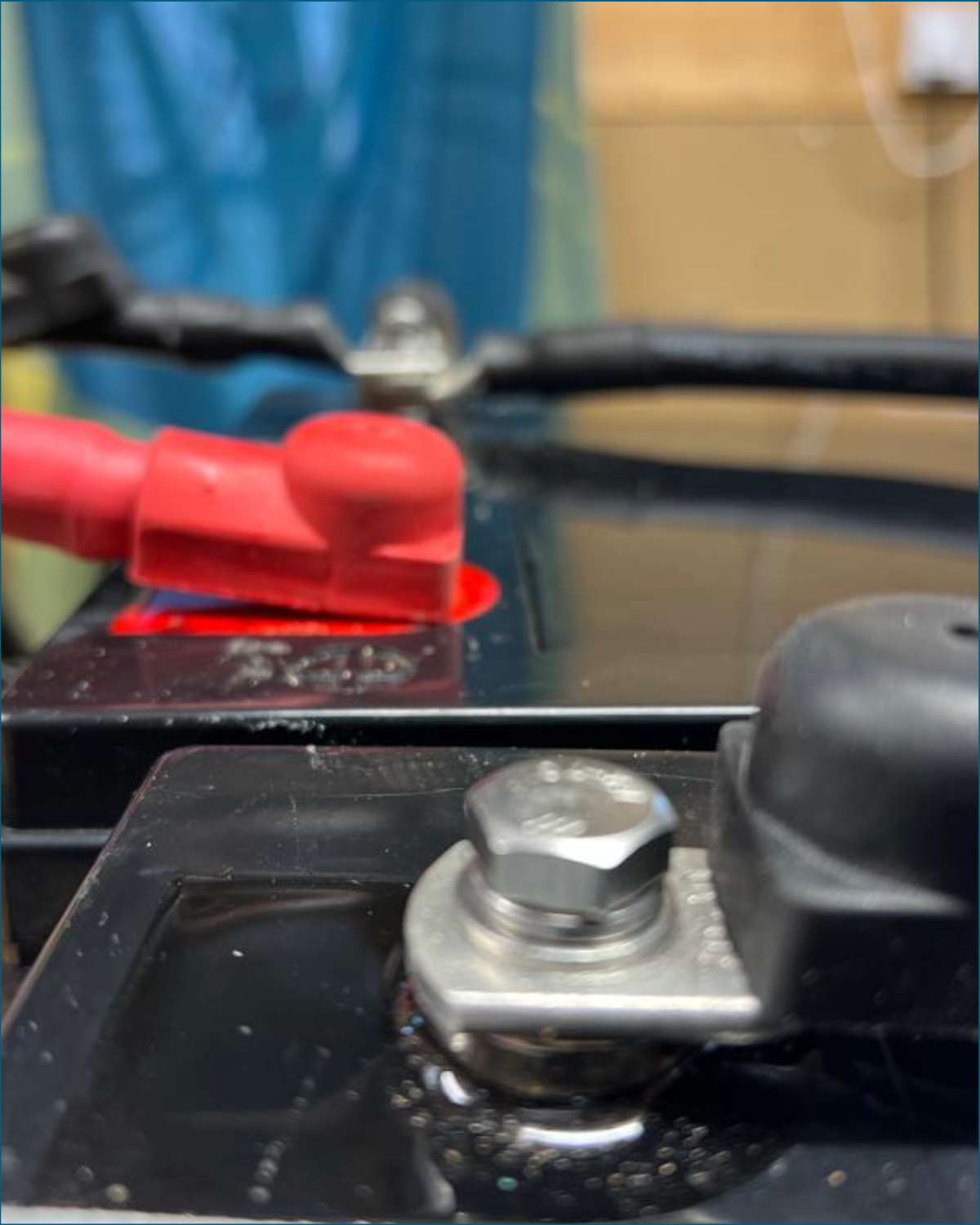Flexible solar panels vs rigid for RVs: which is best? Rigid and flexible solar panels are two of the most popular options for RV owners looking to power their vehicles with renewable energy.
Solar panels have become increasingly popular as more people turn to RV living as a way to travel and explore.
Solar panels provide a sustainable and reliable source of energy. They can power everything from lights and appliances to air conditioning units.
There are several reasons why solar panels are becoming more popular among RV enthusiasts:
- Cost Savings. Solar energy allows RV owners to save money on fuel costs, generator maintenance, and campground fees.
- Convenience. Solar panels provide a reliable energy source even when camping off-grid or during power outages.
- Independence. Solar panels provide greater independence and flexibility when it comes to travel plans.
If you’re considering adding solar panels to your RV, one of the first decisions you’ll need is whether to go with rigid or flexible panels.
Choosing the right type of solar panel for your RV maximizes efficiency and performance.
There are two main types of solar panels – rigid and flexible – each with advantages and disadvantages.
In this article, we’ll take a closer look at the following:
- what rigid and flexible solar panels are,
- their pros and cons when it comes to RV use,
- and how to choose which panel type is best for you.
At A Glance: Flexible Solar Panels Vs Rigid for RVs
Here’s a quick summary of a solar panel’s most important features and which panel type comes out on top.
Rigid Panels
- Efficiency
- Performance
- Durability
- Lifespan
- Cost
Flexible Panels
- Flexibility
- Weight
- Profile
- Ease Of Installation
We’ll look at each of these factors in more detail below.
What Are Flexible Solar Panels?

Flexible solar panels are designed to bend and flex, making them ideal for use on curved edges of your camper’s roof.
These panels are made from thin layers of photovoltaic material embedded in a flexible plastic substrate.
Flexible solar panels typically have a sleek, low-profile design that makes them easy to install on curved surfaces, such as the roof of an RV.
They’re lightweight and can be easily lifted onto your RV’s roof.
They come with wires attached for easy connection to your RV’s battery system via the charge controller.
These wires are usually located on the panel’s backside and can be connected using MC4 connectors.
Three main types of flexible solar panels:
- thin-film,
- polycrystalline, and
- monocrystalline.
Monocrystalline solar cells offer the best efficiency, but each has unique characteristics and benefits.
In terms of thickness, flexible solar panels can vary depending on the manufacturer. However, they generally range from 1-3 mm thick (compared with rigid ones, which can be up to 25mm).
This makes them lightweight and easy to lift and fit.
What Are The Advantages Of Flexible Solar Panels?

- Flexibility. As mentioned above, flexible solar panels can be bent and shaped to fit a variety of surfaces. This makes them a great option if your RV has an irregularly shaped roof or rounded shape like an Airstream.
- Lightweight. Because they’re made from thin layers of material instead of heavy glass or plastic, flexible panels are much lighter than their rigid counterparts.
- Easy installation. Installing flexible solar panels is often easier than installing rigid ones because they can adhere directly to the roof with adhesive backing.
- Low profile. Because they’re so thin and lightweight, flexible solar panels sit close to the roofline and don’t add much height or wind resistance to your RV.
What Are The Disadvantages Of Flexible Solar Panels?

- Lower efficiency. In general, flexible solar panels have lower efficiency ratings than rigid ones. This means they produce less power per square foot than their rigid counterparts.
- Durability concerns. Because they’re not encased in a protective layer like glass or plastic, flexible solar panels may be more susceptible to damage.
What Are Rigid Solar Panels?

Rigid solar panels are designed to be fixed in place and remain stationary.
They are made from photovoltaic cells mounted onto a rigid backing material, typically aluminum or tempered glass.
The most common shape for rigid solar panels is rectangular, with an average thickness of around 25mm.
They can vary, but the most common sizes for residential or RV applications range from 100-400 watts.
Rigid solar panels also have the solar cable attached to the panel’s backside for easy connection to your battery system.
The photovoltaic cells that make up these panels are typically made from silicon, a highly efficient and durable material.
The cells are arranged in a specific pattern on the panel to maximize energy output under direct sunlight.
One crucial feature of rigid solar panels is their durability. They are designed to withstand harsh weather conditions, such as hail or heavy rain, and can last up to 25 years with proper maintenance.
Another important consideration when choosing rigid solar panels is efficiency ratings.
Panels with higher efficiency ratings will generate more power per square meter than those with lower ratings.
This means you can generate more power from smaller panels, saving you precious RV roof space.
What Are The Advantages Of Rigid Solar Panels?

- Durability. The frames on rigid solar panels provide extra protection against impact damage and harsh weather conditions. This makes them ideal for RVs subjected to rough terrain or extreme temperatures.
- Efficiency. Rigid solar panels typically have higher efficiency ratings than flexible ones. This means they can produce more power per square foot of surface area.
- Longevity. With proper care and maintenance, rigid solar panels can last over 25 years. This makes them a long-term investment that can pay off over time.
- Cost. Rigid solar panel systems are slightly cheaper than flexible panels.
What Are The Disadvantages Of Rigid Solar Panels?

- More Complex Installation. Mounting rigid solar panels onto the roof of an RV is relatively straightforward but more involved than flexible panels.
- Weight. Because they are made with a sturdy frame, rigid solar panels tend to be heavier than their flexible counterparts. This can complicate installation and add weight to your overall vehicle load.
- No Flexibility. Unlike flexible solar panels that bend and flex around curves or corners, rigid panels have limited flexibility regarding installation angles. Tilted mounting brackets can help, though.
Detailed Comparison Of Flexible Solar Panels Vs Rigid
Flexible and rigid solar panels are two different types of solar panels with unique characteristics.
This guide will compare the two types of panels across various categories to help you determine which one is right for your needs.
Efficiency
When it comes to efficiency ratings, rigid solar panels tend to be more efficient than flexible ones.
In recent years, the efficiency ratings of flexible solar panels have improved, so they’re almost on par with rigid panels.
This is due to advancements in technology and materials that have allowed manufacturers to produce more efficient, flexible panels.
Rigid panels typically have about 22% efficiency ratings, while flexible solar panels hover at around 20-21%.
This means you’ll need a little more surface area covered by flexible panels to generate the same amount of power as a smaller number of rigid panels.
Performance
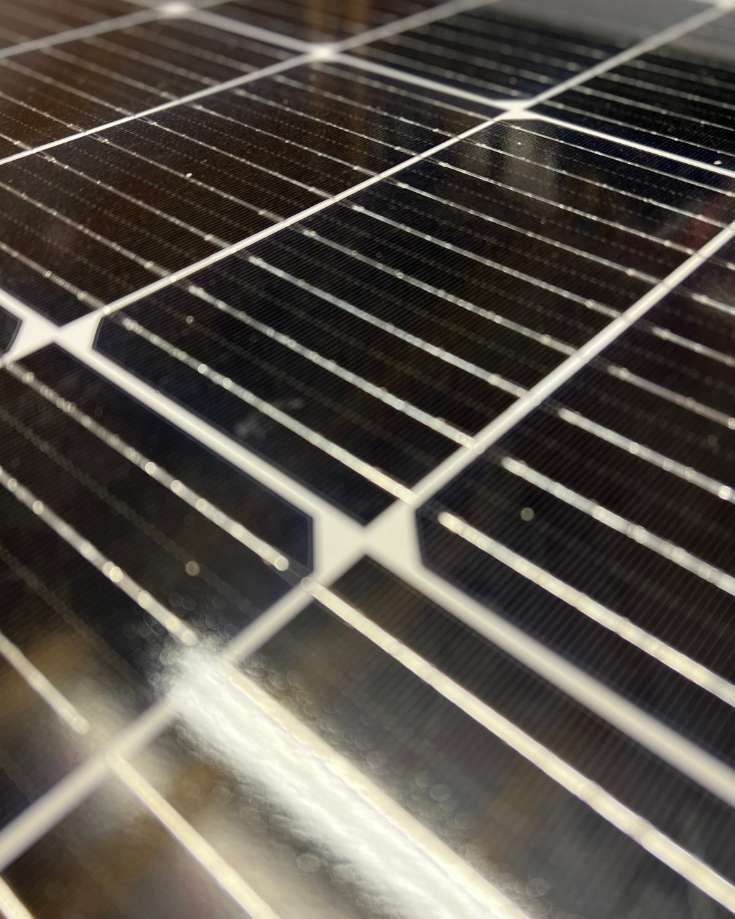
Rigid solar panels perform better than flexible panels due to several factors.
One reason is that the efficiency rating is slightly better, as mentioned above.
But the temperature also affects the performance of both types of solar panels.
Heat can harm the efficiency of solar panels by reducing their ability to convert sunlight into electricity.
This is because as temperature increases, the conductivity of the solar cells decreases. That reduces their efficiency.
In general, rigid solar panels are better at dissipating heat because:
- they’re thicker,
- have a solid backing material, and
- are mounted with an air gap.
This allows them to maintain higher levels of efficiency even when exposed to high temperatures over long periods.
On the other hand, flexible solar panels tend to be thinner and more lightweight in design, making them less effective at dissipating heat.
Durability
Rigid glass panels are generally more durable than their flexible counterparts due to the following:
- their solid construction,
- robust aluminum metal frame, and
- tempered glass coverings.
They can withstand harsh weather conditions like hail, heavy rain, and snow better than flexible ones, which can get damaged easily if not handled properly.
Lifespan
Both solar panels have long lifespans, but rigid ones tend to last longer due to their durability.
A well-maintained rigid panel can last up to 25 years, while flexible ones usually come with a lifespan of around 10 years.
It’s important to note that proper maintenance is vital when extending any solar panel’s lifespan.
Flexibility
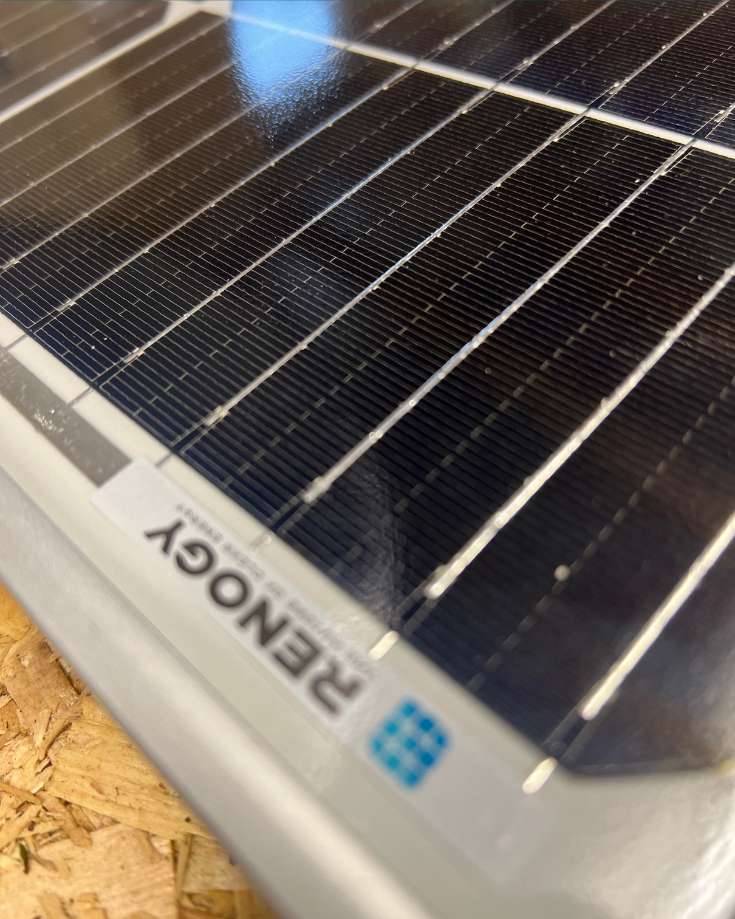
As the name implies, flexible solar panels offer greater flexibility than rigid ones since they can bend and flex without breaking.
This makes them ideal for your RV’s curved surface, where rigid ones would not fit so well.
Flexible options also offer more versatility in terms of installation angles.
That said, generating remote solar power from rigid panels on tilt mounts is one of the most efficient ways to maximize output.
Weight
The lightweight construction of flexible solar panels makes them a much lighter option.
Flexible solar panels weigh around 4lb for 100w panels compared to about 14lb for 100w rigid panels.
That gives you more versatility when mounting them. For example, you could easily mount lightweight panels to your RV or trailer’s front, sides, and back. That would be awkward with a rigid version.
Profile
When it comes to profile, flexible solar panels are much thinner than their bulky counterparts.
Their low-profile design allows them to blend seamlessly into the surface they’re mounted on without adding unnecessary bulkiness or weight.
When we had flexible solar cells on our van, you could barely see them from ground level.
Ease Of Installation
Both types of solar panel systems need some level of expertise when it comes to installation.
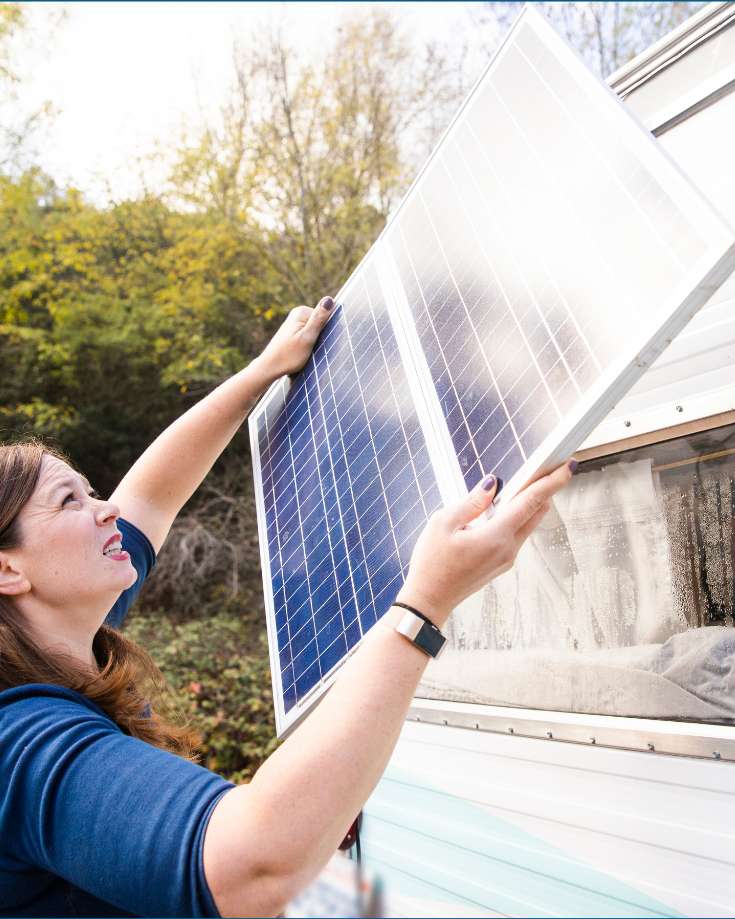
Overall, installing a flexible system is easier than a rigid one because they do not need drilling holes or complex mounting structures.
Simply put: adhesive tapes work fine for most installations!
Cost
Flexible solar panels cost more than rigid ones.
It’s a fact we find incredibly surprising. But thanks to the more complicated solar panel technology and manufacturing process, you can expect to pay about 25% more for flexible panels.
Are Flexible Solar Panels As Good As Solid?
Flexible solar panels are a popular alternative to traditional rigid panels due to their lightweight and versatile design.
However, whether they are as good as solid panels depends on your needs.
In terms of efficiency, rigid panels are more effective at converting sunlight into electricity due to their higher-quality materials and thicker construction.
They also tend to dissipate heat better, which can improve their performance over time.
However, flexible panels have benefits such as being easier to install and lighter weight.
Ultimately, you must weigh the pros and cons of each type of panel based on your needs before making a final decision.
Are Flexible Solar Panels Worth It?
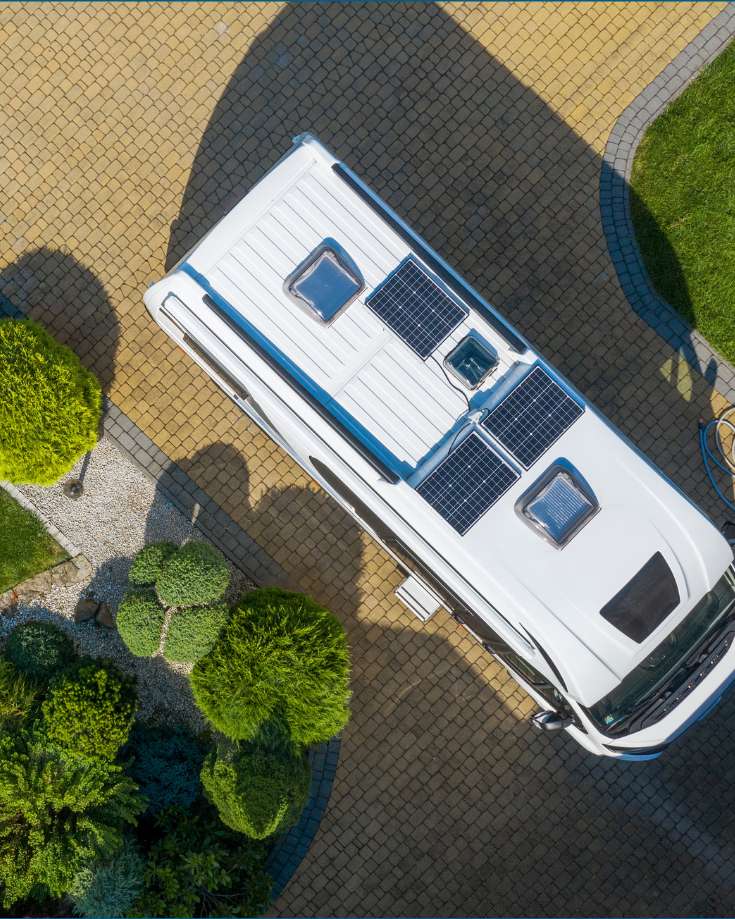
Whether or not flexible panels are worth it depends on your RV needs.
If you need a flexible panel to wrap around the edges of your Airstream, and want to avoid drilling holes into your roof, then flexible panels will be your preferred option.
Otherwise, if performance and efficiency are the most important factors, stick with rigid panels.
Do Flexible Solar Panels Need Airflow?
Flexible panels do not necessarily need airflow but can benefit from it.
Unlike rigid panels, which typically have a built-in frame that allows for natural ventilation, flexible panels are often installed without gaps between the panel and the mounting surface.
This can result in heat buildup on the back of the panel, further reducing its efficiency.
Providing some level of airflow behind the panel can help prevent the issue.
This can be achieved by adding spacers or standoffs between the panel and the mounting surface to create a small gap for air circulation.
Can You Mix Rigid And Flexible Solar Panels?

Mixing rigid and flexible solar panels is possible, but there may be more efficient and effective approaches.
The difference between flexible and rigid panels isn’t important, though.
When you connect multiple panels, you need to configure them in series or parallel. Which you choose could affect the maximum output the solar array can produce.
- Wired in series, we add each panel’s volts and use the lowest current rating.
- Wired in parallel, we add each panel’s current and use the lowest voltage.
Ideally, you want every panel’s voltage and current rating to be precisely the same to maximize your output.
Mixing solar panels with different wattages, voltages or currents will result in some losses.
Can You Step On A Flexible Solar Panel?
Flexible panels are less durable than traditional panels and require some care and caution when handling them.
While stepping on a flexible panel without causing immediate damage is possible, it’s not recommended as a regular practice.
The main concern with stepping on a flexible panel is that it can cause microcracks or other types of damage to the cells inside the panel. Over time, this can lead to reduced efficiency and overall performance of the panel.
To avoid damaging your flexible solar panels, it’s important to handle them with care and avoid putting unnecessary stress on them. This includes avoiding walking or standing on them whenever possible.
How Hot Do Flexible Solar Panels Get?

Flexible solar panels can get quite hot when exposed to direct sunlight for extended periods, but the exact temperature they reach will depend on various factors.
Some of the key factors that can influence how hot flexible solar panels get include:
- the size and type of panel,
- the angle and orientation of the panel relative to the sun,
- the ambient temperature, and
- humidity levels in the surrounding environment.
In general, it’s not uncommon for flexible solar panels to reach temperatures more than 160°F when exposed to direct sunlight for several hours.
To help reduce heat buildup and improve performance, install them with adequate ventilation and airflow.
Flexible Solar Panels Vs Rigid: Which Solar Panel Type Is Best For You?
In summary, if you’re looking for an easy-to-install option that provides flexibility in shape and size requirements for your RV’s rooftop space, then a flexible solar panel might just be what you need!
While they come with some drawbacks, such as lower efficiency ratings than traditional rigid panels, these downsides aren’t necessarily deal breakers depending on how much power output you need.
So it ultimately comes down to personal preference!
Have you had any experience with flexible solar panels? Do you have any tips for keeping them cool or avoiding damage? Leave a comment below!
Graham Bogie

Graham is a seasoned marine electrical engineer with two decades of experience designing customized electrical systems for plant machinery and converting campers and overland vehicles. His expertise has led him to author the reputable Campervan Electrics Handbook and become the chief designer of the RV Wiring Design Tool. As a knowledgeable figure in the field, his YouTube channel, blog, Facebook group, and newsletter, offering electrical advice and product reviews, reach more than a million users each year.


